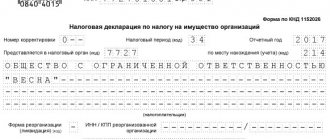Property tax benefits
The object of taxation is property on the balance sheet of an organization. But there are special cases when property is exempt from tax registration.
Benefits are provided to the following categories of persons:
- Heroes of the USSR and the Russian Federation.
- Citizens awarded the Order of Glory.
- Disabled people of the first and second groups.
- Participants of the Second World War and military operations.
- Victims of radiation exposure.
- Military personnel with over 20 years of service and relatives of deceased military personnel.
- For pensioners.
Important! The benefit can only be obtained for one piece of real estate of each type. For example, if a veteran owns two apartments and two private houses, the benefit can be accrued only for one apartment and one house.
Benefit codes
The Tax Code specifies specialized digital combinations to designate each benefit in the declaration.
Tax benefit codes are distributed as follows:
- Institutions of the penal system: 2010221.
- Religious organizations: 2010222.
- Organizations of disabled people: 2010223/2010224/2010225.
- Pharmaceutical organizations: 2010226.
- Federal highways: 2010236.
- SEZ enterprises: 2010253/2010255.
- Management companies: 2010256.
- Prosthetic and orthopedic enterprises: 2010331.
- Lawyers, legal and notary offices: 2010332.
- Scientific centers: 2010333.
Detailed description of the list of subjects
The list of objects that fall under the type of preferential property is established by the Tax Code of the Russian Federation. Any institution that has the status of a state science center, where special equipment is used and employees of the highest categories and degrees work, can own the specified property.
In addition, taxation for the use of objects will not affect the Federal Penitentiary Service of Russia, Academies of Sciences, monuments of national importance, housing and communal services, special storage facilities for radioactive waste, universities, children's and youth sports schools, as well as other institutions. It is worth noting that local governments contribute to the normalization of the activities of these facilities, since their powers extend to the ability to extend benefits.
Important! The above organizations are not prohibited from receiving income from commercial activities. If in the future, from the receipt of such financial resources, objects were purchased, then they can also be considered preferential.
Information obtained through an appropriate request will help determine the objects for which the benefit applies. Such information can be found in the following documents:
- fund classifier;
- OKVED and OKOF, approved by the State Standard of the Russian Federation.
Preferential property
Article 381 of the Tax Code of the Russian Federation contains a list of preferential property for property tax, which includes:
- Assets of institutions of the penal system, the Ministry of Internal Affairs, the prosecutor's office and other law enforcement agencies.
- Real estate of religious organizations.
- Assets of all-Russian public organizations and unions for the disabled.
- Equipment for the production of pharmaceutical products.
- Federal roads.
- Property assets of prosthetic and orthopedic companies.
- Ownership of lawyer or notary offices.
- Property of state companies or research centers.
- Assets of legal entities in special economic zones - SEZ.
- Ownership after the commissioning of high-efficiency equipment - the benefit is valid for three years.
- Property of construction companies.
- Property of management enterprises.
- Water, space vessels and nuclear installations.
Important! In addition to federal benefits, regional benefits also apply if they are provided for by local legislation.
Movable property is property that is not recognized as immovable, that is, it is not closely connected to the land and can be moved without destroying the object. In addition, movable objects are not subject to state registration. From January 1, 2013, the tax on movable property of organizations was abolished.
Important! The law applies only to movable objects - separable, independently functioning.
Tax on movable property of legal entities is not levied on:
- Cable lines.
- Dismantled air conditioners, ventilation systems, alarms.
- ATMs, terminals, advertising structures.
- Vehicle.
- Objects leased.
- A commercial organization organized from a unitary enterprise.
What applies to movable property for tax calculation:
- Communication networks of buildings.
- Built-in air conditioners and ventilation systems.
- Engineering and technical alarm system.
Who is recognized as a property tax payer?
Obligations to pay property tax can be assigned to both organizations that own real estate (buildings, structures, premises) and companies that own movable property (fixed assets, equipment, machinery, etc.). Thus, in the general case, the payer of property tax is a legal entity that owns property (both movable and immovable).
Property as an object of taxation
One of the main criteria for recognizing property as an object of taxation is that the property is recorded on the enterprise’s balance sheet in accounts 01 Fixed assets and 03 Income-bearing investments in assets.
Depreciation groups of fixed assets
Depending on the duration and usefulness of movable property, it is divided into the following groups:
- I - 1-2 years (drilling machines);
- II - 2-3 years (snow removal devices);
- III - 3-5 (devices for the forest industry);
- IV - 5-7 (overhead power lines);
- V - 7-10 (heating main);
- VI - 10-15 (railroads);
- VII - 15-20 (bridges);
- VIII - 20-25 (access railway tracks);
- IX - 25-30 (power plants);
- X - 30 or more (ships).
Property of depreciation groups 1 and 2 are not taxed regardless of the date of its registration and are included in the second section of the tax return.
Tax principles
From 2021 movable property is not subject to tax if it has been registered in 1C since 2013. An exception is property obtained through the following procedures:
- Reorganization/liquidation;
- Transfer of property to a related party.
To correctly display the reasons, the Federal Tax Service has provided for the indication in the reporting documents of enterprises of the benefit code 2010257, indicated in the calculations of advance payments in section 2, line 160.
Reasons for using the benefit
In order to confirm the legality of using property tax benefit code 2010257, refer to:
- acts of acceptance and transfer of fixed assets, which indicate the date of transfer,
- inventory card for property.
Thus, in order to confirm the right to use code 2010257, it is enough to have data on movable property recorded on the balance sheet properly registered in 1C.
Objects of preferential taxation
From 2021 no property tax is paid from the first two depreciation groups according to the OS classification.
All other property contained on the balance sheet of a legal entity is subject to calculation and accrual of tax starting from 2021, with the exception of property registered after January 1, 2013.
Exceptions
The tax benefit is not provided for those types of property that do not fall under the first two depreciation groups. Their value is taken into account when calculating the total average annual value of the enterprise’s property for the period 2021 and 2017.
Exceptions include the following types of property:
- property that has not been fully depreciated, classified as fixed assets of the organization and recorded on the balance sheet until January 2013,
- property items recorded as fixed assets of the company, not fully depreciated, received on the balance sheet of a legal entity in the period 2013-2014. as a result of reorganization of a legal entity or during liquidation.
- property registered since 2013 or 2014 due to transfer or acquisition by a related party;
- fixed assets taken onto the balance sheet later, during 2021 and 2017, due to the liquidation of the enterprise, reorganization, acquisition by a related party.
Supporting documents
When submitting the declaration, the following documents are additionally attached:
- Copy of the passport.
- Individual tax number.
- Copies of papers confirming the fact of ownership of property: agreement of sale and purchase, mortgage, inheritance, gift, etc.
- Certificate of registration of property rights.
How to reflect preferential property in the declaration
It does not need to be reflected in the tax return (sub.
8 clause 4 art. 374 of the Tax Code of the Russian Federation). Movable property of group 3 is reflected as preferential (clause 1 of article 373, clause 25 of article 381, article 386 of the Tax Code of the Russian Federation). In both cases, the property tax of organizations in respect of the mentioned property is not paid. You also need to remember that it is not exempt from taxation of movable property registered as fixed assets from January 1, 2013 as a result of:
- reorganization or liquidation of legal entities;
- transfer, including acquisition, of property between persons recognized as interdependent in accordance with the provisions of paragraph 2 of Article 105.1 of the Tax Code of the Russian Federation.
We recommend reading: What pension is due after years
What an accountant needs to know if there is movable property on the balance sheet
In order to bring tax and accounting data closer together, write-offs can occur evenly, and it is this decision that is fixed in the accounting policy for tax purposes.
In paragraph 4 of Art. 374 of the Tax Code of the Russian Federation lists property that is not recognized as an object of taxation. This list includes land plots, nuclear installations, icebreakers, space installations, as well as fixed assets included in the first or second depreciation group in accordance with the Classification of fixed assets included in depreciation groups.
Consequently, if an organization’s balance sheet contains fixed assets (movable and (or) immovable), named as part of the objects of taxation, it is recognized as a payer of property tax and is obliged to submit a declaration (tax calculation for advance payments) for this tax. The fact that, according to paragraph 25 of Art.
381 of the Tax Code of the Russian Federation in 2021, a preferential tax regime applies to
Using benefit 2010257 as an example
Let us consider in more detail the use of benefit code 2010257 for corporate property tax as an example.
Residual value of fixed assets in the organization on the first day of each month of the reporting period for which a property declaration is drawn up:
| As of date | Residual value of fixed assets recognized as an object of taxation | Incl. value of preferential property |
| January 01 | 1 650 000 | 720 000 |
| February 01 | 1 630 000 | 710 000 |
| March 01 | 1 610 000 | 700 000 |
| April 01 | 1 590 000 | 690 000 |
| May 01 | 1 570 000 | 680 000 |
| June 01 | 1 550 000 | 670 000 |
| July 01 | 1 530 000 | 660 000 |
The tax rate for an organization is 2.2%
Let's do the calculation:
- the average cost of fixed assets for the six months is 1,590,000 rubles. (1,650,000 +1,630,000 + 1,610,000 + 1,590,000 + 1,570,000 + 1,550,000 + 1,530,000) /7;
- the average cost of preferential property for the six months is 690,000 rubles. (720,000 + 710,000 + 700,000 + 690,000 + 680,000 + 670,000 + 660,000)/7;
- the amount of the advance payment for the six months is 19,800 rubles. (1,590,000 - 690,000) * 2.2%.
A sample of filling out a property tax return using benefit 2010257 is attached in Excel and PDF format.
What to do if the region unexpectedly introduced a benefit for movable property from 2021
Submit tax returns correctly Stay up to date with changes and current accounting issues for VAT, income tax, personal income tax, insurance premiums Express course
If your region adopted a movable property benefit during 2018, then, in fact, it was adopted “retroactively.” If you found out about this in the middle of the year, then there is no need to redo the calculation of the advance payment for property tax for previous reporting periods. It will be possible to take into account the benefit for the tax period when submitting the declaration.
If you decide not to redo the calculations taking into account the benefits, then this will not pose any threat during inspections. The overpayment of the advance payment will be taken into account based on the results of the tax period.
An example of how to correctly calculate an advance payment with a benefit and a rate of 1.1%
Condition: average cost of fixed assets 3 -10 depreciation groups for half a year - 50,000,000 rubles, incl. movable property accepted for accounting after January 1, 2013 - 10,000,000 rubles. According to regional law, preferential treatment applies to property from the date of release of which no more than 3 years have passed. The average cost of such property is RUB 2,000,000. The rest of movable property is taxed at a rate of 1.1%. The general tax rate is 2.2%.
Solution:
- the average value of property taxed at a rate of 1.1% is RUB 8,000,000. (RUB 10,000,000 – RUB 2,000,000);
- advance payment at a rate of 1.1% - 22,000 rubles. (RUB 8,000,000 x 1.1% / 4);
- the average value of property taxed at a rate of 2.2% is 40,000,000 rubles. (RUB 50,000,000 – RUB 2,000,000 – RUB 8,000,000);
- advance payment at a rate of 2.2% - 220,000 rubles. (RUB 40,000,000 x 2.2% /4);
- the total payment amount for the six months is RUB 242,000. (RUB 220,000 + RUB 22,000).
Property tax benefit codes: order of reflection in the calculation and declaration
| Benefit code in Calculation | Benefit code in the declaration | Expert commentary |
| Line 130 “Tax benefit code” | Line 160 “Tax benefit code” | In the first part, indicate the benefit code in accordance with Appendix No. 6 to the Procedure for filling out the calculation. For example:
Only when indicating benefit 2012000, fill out the second part of line 130 (160) - the number, paragraph and subparagraph of the article of the regional law that establishes the benefit. For benefits with codes 2012400 and 2012500, do not fill out line 130 (160). |
| Line 160 “Tax benefit code (established in the form of a reduction in the tax rate) | Line 200 “Tax benefit code (established in the form of a reduction in the tax rate) | Fill out according to regional legislation.
If your organization is not one of the taxpayers for whom a benefit in the form of a rate reduction has been established, put a dash in this line. |
| Line 190 “Tax benefit code (in the form of a reduction in the amount of tax payable to the budget)” | Line 240 “Tax benefit code (in the form of a reduction in the amount of tax payable to the budget)” | Fill in only if the law of a subject of the Russian Federation has established a tax benefit for a certain category of taxpayers in the form of a reduction in the amount of tax payable to the budget:
|
Where did benefit code 2010257 go from 2021?
Please note that benefit code 2010257 was used for federal benefits in accordance with clause 25 of Art.
381 Tax Code of the Russian Federation. The federal benefit was valid until January 1, 2018.
From 2021, movable property specified in paragraph 25 of Art. 381 of the Tax Code of the Russian Federation, is exempt from property tax only if regional legislation provides for this benefit. Thus, benefit code 2010257 is no longer used (letter of the Federal Tax Service of Russia dated March 14, 2018 No. BS-4-21/). Instead, for the benefit for movable property registered after January 1, 2013, code 2012000 is used.
Also in connection with the transfer of benefits from the federal to the regions and under clause 21 of Art. 381 of the Tax Code of the Russian Federation the following codes cannot be used in 2021:
- 2010337 - in relation to newly commissioned facilities with high energy efficiency, in accordance with the List from the Appendix to the Decree of the Government of the Russian Federation of June 17, 2015 No. 600;
- 2010338 - in relation to newly commissioned facilities with a high energy efficiency class, in accordance with the List from the Appendix to the Decree of the Government of the Russian Federation dated December 31, 2009 No. 1222.






